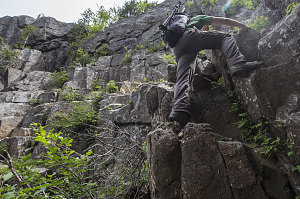The Trap Dike is indeed a "real" dike: a geologic formation where a line of newer, younger rock cuts through existing rock. The Central High Peaks region of the Adirondacks has many examples of intrusive igneous dikes, but this one (to my knowledge, anyway) is by far the largest. Consisting of softer rock - gabbro - than that of the general mass of the High Peaks, the Trap Dike has eroded over the eons into - especially at the bottom - into a large vertically-walled rock canyon, about 20 yards wide. In a broad sweep - steeper at the bottom and punctuated with a few steps, the floor of the Dike rises up steeply to intersect the ridgeline of Mount Colden itself, a couple of hundred yards northeast of the summit. Into this rising rock canyon we now went, starting the climbing part of our day.
Approaching the Scrambling
We soon clambered over the loose talus and debris and started climbing the actual bedrock in the dike. The gabbro has fractured into wonderfully positive squared-edged blocks, making for very reassurring climbing holds.
As I mentioned earlier, this was the first time I'd been in the Trap Dike in the summer since the big landslide of 2011. It was indeed much more barren than I remembered from years past - although a few trees had managed to survive on the right-hand side, and many small new bushes had started to grow here and there. The landslide had scoured out at least 90% of the existing trees and vegetation. The dike now has a more elemental, more alpine feel to it.

Almost Staircase
The lower dike has a couple of steeper pitches that I like to refer to as "the first step" and "the second step". The first step consists of the aforementioned excellent blocky handholds and is about a class 3 on the Yosemite Decimal Climbing scale. To put it another way, you need to use your hands to climb, but a fall will not likely result in a serious injury. We enjoyed the quick scramble up this first step, arriving at a kind of landing in the floor of the dike. Immediately after this landing, the floor of the dike rises again to the larger, steeper and more difficult-to-climb second step.
Nearing top of First Step
